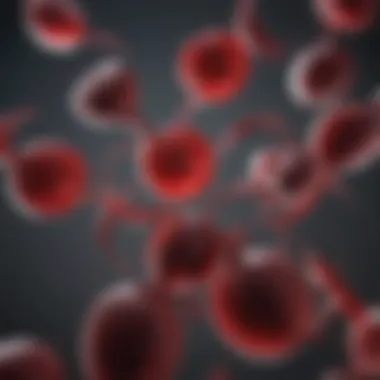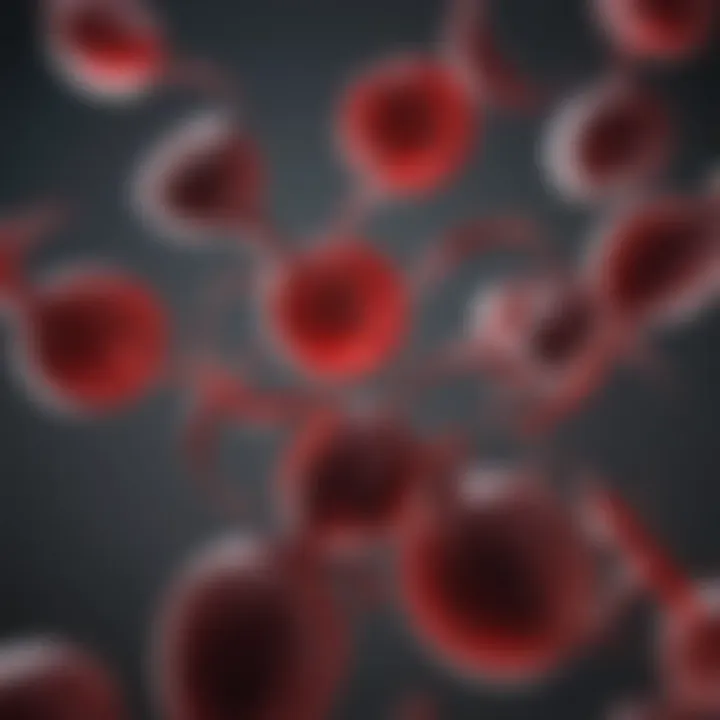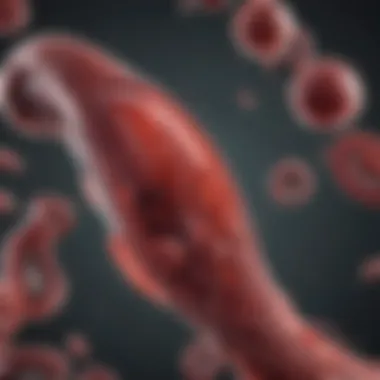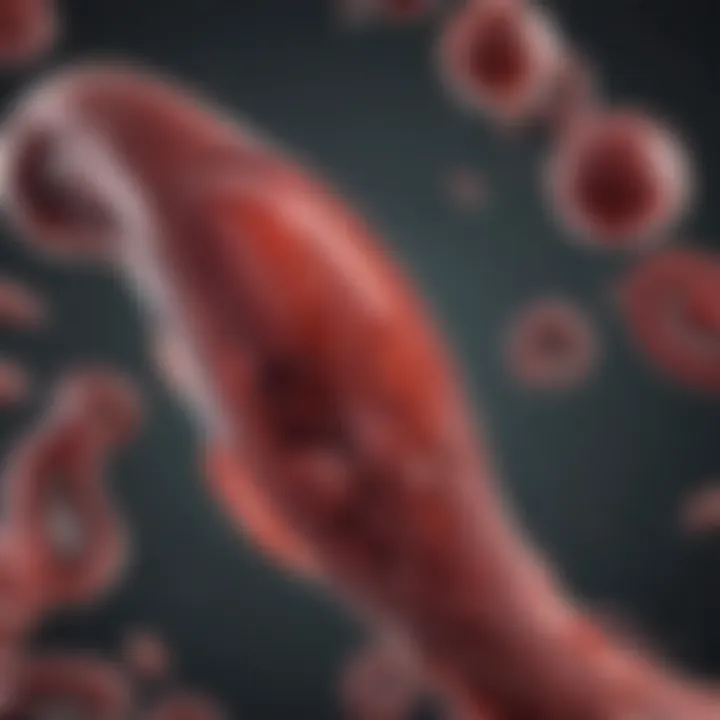Sickle Cell Anemia: A Malaria Resistance Insight


Intro
Sickle cell anemia presents a unique phenomenon in the realms of genetics and public health. This blood disorder, characterized by the presence of abnormal hemoglobin, not only poses significant health issues but also offers intriguing advantages in certain regions. Notably, individuals with sickle cell trait exhibit increased resistance to malaria, a deadly disease transmitted by mosquitoes. Understanding this relationship is paramount for both scientific and public health discussions, particularly in areas where malaria is endemic.
In this article, we will delve deeper into how sickle cell anemia acts as a protective mechanism against malaria. This examination will encompass genetic mechanisms, biological implications, and potential strategies for improving health outcomes in affected regions. The interplay between sickle cell and malaria resistance offers a captivating glimpse into evolutionary adaptation, highlighting the vital importance of genetics in human health.
Research Overview
Methodological Approaches
To analyze the complex relationship between sickle cell anemia and malaria resistance, researchers have employed various methodological approaches. These methods include genetic sequencing, epidemiological studies, and field research in endemic areas.
- Genetic Sequencing: By examining the genes responsible for hemoglobin structure, scientists can differentiate between normal and sickle cell traits. This allows for a better understanding of how these genetic variations provide resistance to malaria.
- Epidemiological Studies: These studies investigate the prevalence of malaria in populations with high instances of sickle cell anemia. Gathering data on health outcomes among different groups provides valuable insights into the protective mechanisms at play.
- Field Research: Conducting research in the affected regions enables scientists to observe interactions between malaria parasites and host populations. This can shed light on the biological effects of the sickle cell trait in real-world contexts.
Significance and Implications
The significance of understanding sickle cell anemia's protective role against malaria extends beyond academia. Here are several implications of this research:
- Public Health Strategies: Enhanced understanding can lead to targeted health interventions in populations at risk. This could include education about sickle cell trait screening and malaria prevention measures.
- Educational Outreach: Raising awareness about the benefits of possessing sickle cell trait can help dispel myths and encourage carriers to participate in screening programs.
- Future Research Directions: Identifying key genetic markers associated with malaria resistance may help develop new therapeutic approaches to combat malaria, potentially saving lives.
"Understanding the connection between sickle cell anemia and malaria resistance embodies the dynamic interaction between genetics and disease, offering crucial insights for public health strategies in affected regions."
Current Trends in Science
Innovative Techniques and Tools
Recent advancements in genetic research and data analysis have fostered innovative techniques for studying sickle cell anemia and malaria dynamics. Some cutting-edge tools include:
- CRISPR-Cas9: This powerful gene-editing technology allows scientists to manipulate genes related to hemoglobin production, offering potential new avenues for treatment.
- Genome-Wide Association Studies: These studies identify genetic variations that contribute to malaria resistance, paving the way for personalized medicine approaches.
Interdisciplinary Connections
The study of sickle cell anemia's relationship with malaria involves various disciplines, including:
- Epidemiology: Investigating how diseases spread within populations provides a broader context for understanding health impacts.
- Genetics: Analyzing heredity and genetic variations furthers comprehension of the sickle cell trait's importance and its role in shaping human health on a global scale.
By integrating findings from genetic studies, epidemiological research, and public health initiatives, a more comprehensive picture of sickle cell anemia and malaria resistance emerges.
Foreword to Sickle Cell Disease
Sickle cell disease (SCD) is a group of inherited blood disorders that have profound implications for public health, especially in areas where malaria is prevalent. Understanding SCD is crucial for grasping its relationship with malaria resistance. The pathophysiology of the disease is rooted in genetic abnormalities affecting hemoglobin production. This condition alters the shape and function of red blood cells, leading to various clinical complications.
Exploring sickle cell disease allows us to uncover how this genetic trait, which might seem disadvantageous, confers significant resistance against malaria. The frequency of sickle cell alleles increases in populations exposed to endemic malaria. This survival advantage highlights a fascinating dynamic of human evolution and genetic diversity.
Additionally, sickle cell disease raises essential considerations regarding healthcare, economic impact, and community awareness initiatives, especially in regions like Sub-Saharan Africa. By understanding the basics of sickle cell disease, we can appreciate how it shapes health outcomes in areas burdened by malaria.
Genetic Basis of Sickle Cell Disease
Sickle cell disease originates from a mutation in the HBB gene, which provides instructions for making beta-globin, a crucial component of hemoglobin. The mutation causes hemoglobin to polymerize under low oxygen conditions, resulting in the characteristic sickle shape of red blood cells. This defect can affect the blood's ability to transport oxygen efficiently, leading to various clinical symptoms.
Inheriting one copy of the mutated gene from each parent results in homozygous sickle cell disease. On the other hand, individuals who inherit one mutated and one normal gene are carriers and usually do not exhibit symptoms. This carrier state is referred to as sickle cell trait and offers a protective advantage against malaria, which we will explore further.


Demographics of Sickle Cell Disease Worldwide
Sickle cell disease predominantly affects individuals of African, Mediterranean, Middle Eastern, and Indian descent. The global distribution of the sickle cell trait largely overlaps with regions endemic to malaria. Approximately 300,000 births with sickle cell disease occur each year, mostly in resource-limited settings. In these populations, sickle cell disease often goes unrecognized and untreated, raising challenges for healthcare systems.
Countries with the highest prevalence of sickle cell include Nigeria, the Democratic Republic of the Congo, India, and several others in West and Central Africa. The demographic characteristics reveal that while sickle cell disease is a genetic disorder, its impacts are deeply intertwined with socio-economic factors, health infrastructure, and public health awareness.
Symptoms and Clinical Manifestations
Sickle cell disease presents various symptoms, primarily due to the sickling of red blood cells and their reduced lifespan. Common symptoms include:
- Anemia: Resulting from the chronic destruction of sickle-shaped cells, leading to fatigue and weakness.
- Pain Crises: Sudden episodes of severe pain caused by reduced blood flow (vaso-occlusive crises), often affecting the chest, abdomen, and joints.
- Infections: Individuals with sickle cell disease are at increased risk for infections due to splenic dysfunction.
- Acute Chest Syndrome: A severe complication presenting with chest pain, fever, and respiratory symptoms, often triggered by infections.
These complications pose significant clinical management challenges and highlight the importance of early diagnosis and comprehensive care. Awareness and treatment strategies are essential for improving outcomes for individuals affected by this condition.
"Understanding sickle cell disease is key to grasping its role in resistance to malaria, illustrating the complex interplay of genetics and public health."
As we delve further into malaria, the interplay between sickle cell disease and this parasitic infection will become clearer, reinforcing the critical need for health strategies tailored to these unique populations.
Understanding Malaria
Understanding malaria is crucial for appreciating the impact it has on global health. This parasitic disease continues to cause significant morbidity and mortality in many parts of the world. Insights into malaria's complexity help researchers and healthcare professionals devise more effective interventions and treatments. In this section, we will explore several key aspects of malaria, emphasizing its pathogenesis, distribution, and public health implications.
Overview of Malaria Pathogenesis
Malaria is caused by protozoan parasites of the Plasmodium genus, with Plasmodium falciparum being the most virulent species. The life cycle of malaria involves two main hosts: humans and female Anopheles mosquitoes. The pathogenesis begins when an infected mosquito bites a human, introducing sporozoites into the bloodstream. These sporozoites travel to the liver, where they invade liver cells and multiply. After a short incubation period, the parasites leave the liver and enter the bloodstream, invading red blood cells.
Inside red blood cells, malaria parasites undergo asexual reproduction, resulting in the rupture of the host cells and the release of new parasites. This cycle not only leads to anemia but also initiates a robust immune response that causes fever and other systemic symptoms. The cyclic nature of the infection results in periodic bouts of fever, making malaria a variable and unpredictable disease. Understanding these mechanisms is essential for designing targeted therapies and preventatives, such as vaccines.
Global Distribution of Malaria
Malaria is primarily endemic in tropical and subtropical regions. Areas with high malaria transmission include sub-Saharan Africa, parts of Southeast Asia, and Latin America. The distribution of malaria is influenced by environmental factors such as rainfall, temperature, and the presence of suitable mosquito breeding sites. Access to health care and preventive measures like insecticide-treated bed nets also play crucial roles in malaria prevalence.
Nearly 228 million cases of malaria were reported worldwide in 2018, with over 400,000 deaths, making it a pressing public health concern.
In sub-Saharan Africa, Plasmodium falciparum dominates, contributing to substantial health burdens. Conversely, regions in Asia and South America experience malaria caused by other species like Plasmodium vivax. Despite progress in malaria control, factors like urbanization and climate change threaten to alter malaria distribution, making continued research and surveillance vital.
Impact of Malaria on Public Health
The impact of malaria extends far beyond individual health. It poses significant challenges to public health systems, economies, and social stability in endemic areas. Malaria affects economic productivity due to lost workdays and healthcare costs. Hospitalizations and treatments consume substantial healthcare resources, straining already limited healthcare infrastructures.
In children, malaria can lead to severe complications, resulting in high mortality rates. Pregnant women also face increased risks of severe illness, contributing to adverse pregnancy outcomes. The interplay between malaria and socio-economic factors creates a cycle of disadvantage for affected populations.
The Sickle Cell Trait and Malaria Resistance
The relationship between sickle cell trait and malaria resistance is a critical area of study in understanding human health in malaria-endemic regions. The sickle cell trait, arising from a mutation in the hemoglobin gene, offers an unexpected protective mechanism against malaria, particularly from Plasmodium falciparum, which is responsible for the most severe forms of the disease. This section aims to outline how this genetic predisposition manifests as a beneficial adaptation, providing a survival advantage to individuals who carry the trait.
Mechanisms of Protection
The protective mechanisms of the sickle cell trait against malaria are both biological and biochemical. When the Plasmodium falciparum parasite infects a red blood cell, it modifies the cell's normal behavior. In individuals with sickle cell trait, some red blood cells can assume a sickled shape under low oxygen conditions, making them less hospitable to the malaria parasite. This abnormality leads to several outcomes:
- Reduced Parasite Survival: Sickle-shaped cells tend to lyse more readily than normal cells, leading to a condition that is unfavorable for the malaria parasite's lifecycle.
- Immune System Activation: The presence of sickled cells can stimulate the body’s immune response, making it easier to detect and eliminate infected cells.
- Altered Environment for Parasites: Sickle cell trait creates an environment where the malaria parasite is less likely to thrive, further contributing to the resistance observed in affected individuals.
Evidences from Epidemiological Studies


Epidemiological studies have provided substantial evidence supporting the correlation between sickle cell trait and decreased malaria mortality rates. Research indicates that individuals with the sickle cell trait (carriers) exhibit lower rates of severe malaria compared to those without the trait. Some key findings from these studies include:
- Survival Advantage: In regions with high malaria prevalence, individuals with the sickle cell trait show increased survival rates over generations. This survival advantage has led to the geographic prevalence of sickle cell alleles in malaria-endemic regions, particularly sub-Saharan Africa.
- Statistical Analysis: Various studies highlight that the risk of severe malaria is significantly reduced for carriers of the sickle cell gene variant. Estimates suggest that carriers have about 60% less chance of developing severe malaria than non-carriers.
The reduced severity of malaria in individuals with sickle cell trait highlights the complex interactions between genetics and disease.
Interactions Between Sickle Cells and Malaria Parasites
Understanding the interaction between sickle cells and malaria parasites provides further insight into the biological underpinnings of resistance. The sickling mechanism not only alters the structure of red blood cells but also influences the life cycle of the malaria parasite. Notable interactions include:
- Disruption of Parasite Lifecycle: Once inside a sickled red blood cell, the parasite is less capable of multiplying and completing its lifecycle, leading to reduced parasite load.
- Increased Clearance by the Spleen: Sickle cells are removed more effectively by the spleen, which filters blood and eliminates abnormal cells. This enhances the overall clearance of malaria-infected cells.
- Competitive Advantage: In areas with high malaria transmission, individuals without the sickle trait face a higher disease burden. The selective advantage of the sickle cell trait in these environments underscores the evolutionary implications of this genetic adaptation.
Evolutionary Perspective on Sickle Cell and Malaria
Understanding the evolutionary perspective on sickle cell anemia provides essential context for its relationship with malaria resistance. The sickle cell trait is not merely a genetic anomaly; it exists as a survival tool shaped by the pressures of natural selection. In regions where malaria is prevalent, individuals carrying the sickle cell gene often demonstrate greater survival rates compared to those without it. This adaptive advantage is critical for comprehending the broader implications of sickle cell anemia.
The duality of sickle cell disease underscores a paradox: while it can lead to severe health complications, it also offers protection against malaria. This section will delve into the layers of natural selection, geographic prevalence of sickle cell alleles, and the co-evolution with malaria parasites.
Natural Selection and the Sickle Cell Trait
Natural selection plays a vital role in the propagation of the sickle cell trait. The gene responsible for sickle cell anemia provides resistance to Plasmodium falciparum, the parasite causing malaria. By conferring a survival advantage, it becomes naturally selected in populations exposed to malaria.
- Heterozygous Advantage: Individuals with one sickle cell allele (HbAS) experience a condition known as sickle cell trait. These individuals are less likely to suffer from severe malaria compared to non-carriers. This underlines why the trait remains prevalent in malaria-endemic regions.
- Adaptive Response: The frequent selection of the sickle cell allele is evident in sub-Saharan Africa, parts of India, and the Mediterranean. Specific environmental conditions dictate how genes are favored, demonstrating human adaptability in response to disease.
"The resilience of sickle cell allele in certain populations illustrates a complex interaction between genetics and environment."
Geographic Distribution of Sickle Cell Alleles
The geographic distribution of sickle cell alleles is tightly connected to malaria incidence. Sickle cell anemia is most commonly found in areas where malaria has historically posed a significant threat to human populations. For example:
- Sub-Saharan Africa: This region has the highest prevalence of the sickle cell trait. Approximately 25% of the population in certain areas carry the HbS allele.
- India and the Mediterranean: Smaller populations exhibit similar genetic patterns due to prior malaria exposure.
The linkage between malaria and the geographic frequency of the sickle cell trait is evident. The alleles spread through generations, influenced by selective pressures from endemic malaria.
Co-evolution of Humans and Malaria Parasites
The concept of co-evolution reflects a dynamic interplay between human genetics and malaria. As humans evolved and adapted to combat malaria, so too did the parasites.
- Malaria Adaptation: Plasmodium parasites also develop resistance. This ongoing race between human resistance and parasite adaptation signifies a complex struggle for survival.
- Cultural Practices: Human behaviors and interventions such as bed net use and antimalarial drugs affect the evolutionary trajectory of both humans and malaria.
Through understanding the co-evolutionary processes, it becomes evident that both humans and malaria parasites are engaged in a continual biological exchange.
In summation, the evolutionary perspective forms a key component of the relationship between sickle cell anemia and malaria. This intricate interplay of genetics emphasizes the resilience of human populations and their relentless battle against infectious diseases.
Sickle Cell Disease and Societal Implications
Sickle cell disease is not only a medical condition; it intersects with many aspects of society, including healthcare access, economic stability, and public awareness. Understanding the societal implications of sickle cell disease is crucial for creating effective health strategies and improving the lives of those affected. The relationship between sickle cell trait and malaria resistance offers essential insights into public health and community welfare.
Healthcare Challenges
One primary issue for individuals with sickle cell disease is the lack of proper healthcare services. Many regions that have high rates of sickle cell disease, especially in Africa and parts of India, also struggle with inadequate healthcare infrastructure. This results in delayed diagnosis and treatment. Moreover, the complications of sickle cell disease can lead to repeated hospital visits and lengthy stays, which can strain resources. Patients may experience frequent crises and require ongoing management of pain and other symptoms.


"Sickle cell disease presents significant healthcare challenges that demand urgent attention."
Access to effective treatments like hydroxyurea and blood transfusions is limited in many areas. Healthcare professionals often lack adequate training in managing the disease, which can lead to misdiagnosis. The consequence is a gap in care which directly impacts the quality of life of patients and their families.
Economic Burden on Affected Populations
The economic implications of sickle cell disease are profound. Families affected by this condition may face increased medical expenses, which can be devastating, especially in low-income settings. In addition to direct costs, there are also indirect costs related to lost productivity. Parents may need to take time off work to care for their children, or adult patients may find it challenging to maintain consistent employment.
The aggregate economic effect contributes to a cycle of poverty. According to some studies, the financial burden can inhibit access to education for children in affected families. As a result, communities may experience stunted growth, poor health outcomes, and ongoing economic challenges.
Advocacy and Awareness Initiatives
Raising awareness of sickle cell disease plays a fundamental role in addressing the challenges faced by affected individuals. Advocacy initiatives can help inform the public about the genetic nature of the disease and its linkage to malaria resistance. NGOs and health organizations are essential in promoting education and prevention strategies. Community outreach programs have been effective in places like Sub-Saharan Africa, where stigma often surrounds the disease.
Healthcare campaigns can encourage early screening and genetic counseling, leveraging the unique connection sickle cell anemia has with malaria as a wedge to enhance public interest. Increasing visibility of the disease can mobilize funding for research and healthcare services focusing on affected populations. Collaboration between governments, health institutions, and community leaders will be vital in this effort.
Current Research Directions
Current research direction in sickle cell anemia highlights the ongoing efforts to understand this complex relationship between genetic traits and malaria resistance. This segment is crucial as it can potentially reshape the landscape of treatment options and public health initiatives. The key aspects of this research focus on innovative treatment methods, genetic research, and vaccine development against malaria. Enhancing our understanding in these areas may facilitate better health outcomes for individuals with sickle cell disease, particularly in malaria-endemic regions.
Innovations in Treatment for Sickle Cell Disease
Innovations in the treatment of sickle cell disease are vital for improving patients' quality of life. New therapies are being explored, including hydroxyurea, which helps increase fetal hemoglobin levels, thereby reducing sickle cell crises. Furthermore, recent advancements in blood transfusion techniques and pain management strategies are shaping treatment protocols significantly. Researchers also investigate the potential of CRISPR gene editing technology to directly correct the mutations that cause sickle cell anemia. This approach holds promise for providing a long-term solution to this genetic disorder.
Genetic Research and Gene Therapy Perspectives
The field of genetic research is crucial to understanding the mechanisms behind sickle cell anemia and its interplay with malaria. Currently, significant attention is given to how certain genetic variations of hemoglobin can offer protection against malaria. Studies are focusing on identifying specific genes that enhance survival rates in sickle cell carriers when exposed to malaria.
Gene therapy is emerging as a key method to address the root cause of sickle cell disease. Therapies aiming to replace faulty genes are in experimental phases. Institutions like the National Institutes of Health (NIH) and several universities are conducting trials to evaluate these therapies. These advancements can change the prognostic outlook for many patients, offering hope for a complete cure.
Studying Malaria Vaccine Development
Efforts to develop vaccines against malaria have gained momentum, especially in light of the relationship between sickle cell anemia and malaria resistance. Researchers are focusing on various vaccine candidates, exploring how modifying certain antigens can create an effective immune response. Innovative technologies, such as mRNA vaccines, which have recently gained attention, might provide a new approach to tackling malaria. The connection between sickle cell traits and the immune response to malaria also emerges as an area of study.
In summary, ongoing research directions concentrate on innovations and advancements in the treatment of sickle cell disease, genetic studies, and vaccine development against malaria. Understanding these components deepens the interplay between genetics and infectious diseases, providing critical insights into public health strategies in affected populations.
Finale
Understanding the relationship between sickle cell anemia and malaria resistance is crucial for both public health and genetic research. This article exposes how the sickle cell trait provides a survival advantage in malaria-endemic regions. The complex interplay between genetic factors, malaria pathogenesis, and the socio-economic context must not be overlooked. Those directly affected by sickle cell disease often face numerous challenges, including healthcare access and economic burdens. Thus, comprehending this protective mechanism helps to frame future interventions.
Key Insight: The sickle cell trait highlights a remarkable instance of natural selection, where an apparent disadvantage transforms into a defensive measure against a deadly infectious disease.
Advancing our knowledge regarding this relationship will pave the way for more effective health strategies. It includes adjusting treatment protocols and improving awareness campaigns. Moreover, guidelines built on data driven insights will be instrumental in resource distribution and healthcare policy formulation.
Summary of Key Findings
The exploration of sickle cell anemia and its protective benefits against malaria reveals several important findings:
- The sickle cell trait, while causing health issues, enhances resistance to malaria.
- Genetic variations, resulting from mutations, demonstrate the impact of evolution on human genetics.
- The geographic distribution of sickle cell alleles correlates strongly with malaria prevalence, presenting a clear illustration of natural selection.
- Epidemiological studies validate these findings through increased survival rates among carriers in malaria-endemic areas.
The implications of these findings stretch into various fields, including medicine, genetics, and public health policy. The data collected provides fertile ground for developing new treatment options and health initiatives.
Implications for Future Research
Research should focus on the following areas to better understand the dynamics of sickle cell anemia and malaria resistance:
- Genetic Exploration: Further studies on genomes will deepen comprehension of the mechanisms behind the sickle cell trait and its resistance properties.
- Clinical Trials: Innovative treatments emerging from genetic insights, such as gene therapy, must undergo rigorous testing to assess their viability.
- Public Health Frameworks: Developing data-informed frameworks to address sickle cell as part of malaria control strategies is essential.
- Interdisciplinary Research: Collaboration between geneticists, epidemiologists, and healthcare practitioners will enhance the understanding of these interconnected topics.
By directing research toward these areas, we can expect new advancements that not only improve the quality of life for sickle cell patients but also fortify public health defenses against malaria.



